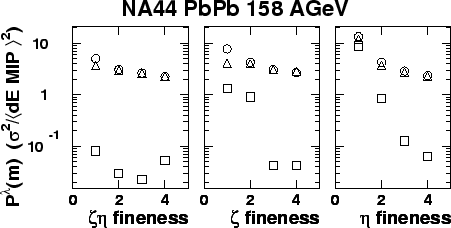 |
 |
The average event, formed by summing amplitude images of the
measured events in a given multiplicity bin,
and dividing by the number of events, has a much reduced texture as
statistical fluctuations cancel (shown as
![]() in Fig.6.11).
Average events retain the
texture associated with the shape of
in Fig.6.11).
Average events retain the
texture associated with the shape of
![]() , with the dead
channels and the finite beam geometrical cross-section
(though this is only partially visible in the average event,
due to the fact that event averaging is done
without attempting to select events according to the vertex position).
, with the dead
channels and the finite beam geometrical cross-section
(though this is only partially visible in the average event,
due to the fact that event averaging is done
without attempting to select events according to the vertex position).
![]() is proportional to the variance, or squared fluctuation
is proportional to the variance, or squared fluctuation
![]() .
Therefore, for Poissonian statistics of hits in a pad, the event
averaging over
.
Therefore, for Poissonian statistics of hits in a pad, the event
averaging over ![]() events should decrease
events should decrease
![]() by
a factor of
by
a factor of ![]() .
The average event whose power spectrum is shown on
Fig. 6.11 is formed by adding
.
The average event whose power spectrum is shown on
Fig. 6.11 is formed by adding
![]() events,
however its
events,
however its
![]() is down less than
is down less than
![]() compared to
that of the single events.
This demonstrates that the average event's texture is
not due to statistical fluctuations, but rather,
predominantly due to the systematic uncertainties listed.
Consequently, we can use the average event's
compared to
that of the single events.
This demonstrates that the average event's texture is
not due to statistical fluctuations, but rather,
predominantly due to the systematic uncertainties listed.
Consequently, we can use the average event's
![]() to estimate
the magnitude of the static texture-related systematics.
As seen from Fig. 6.11, the systematics
are orders of magnitude below the
to estimate
the magnitude of the static texture-related systematics.
As seen from Fig. 6.11, the systematics
are orders of magnitude below the
![]() of single events
(true or mixed),
with the exception of pseudorapidity, where
non-constancy of
of single events
(true or mixed),
with the exception of pseudorapidity, where
non-constancy of
![]() over the detector's
acceptance is visible.
over the detector's
acceptance is visible.
The way to get rid of the ``trivial'' or static texture is to use mixed
events, taking different channels from different events.
The mixed events preserve the texture associated with the
detector position offset,
the inherent
![]() shape and the dead channels.
This is static texture as it produces
the same pattern event after event while
we are searching for evidence of dynamic texture.
We reduce sources of the static texture in the
power spectra by empty target subtraction and by subtraction of mixed
events power spectra, thus obtaining the dynamic texture
shape and the dead channels.
This is static texture as it produces
the same pattern event after event while
we are searching for evidence of dynamic texture.
We reduce sources of the static texture in the
power spectra by empty target subtraction and by subtraction of mixed
events power spectra, thus obtaining the dynamic texture
![]() .
In order to reproduce the electronics cross-talk effects
in the mixed event sample, the mixing is done sector-wise, i.e. the
sectors constitute
the subevents subjected to the event number scrambling.
Its multiplicity dependence is plotted on Figure 7.1.
.
In order to reproduce the electronics cross-talk effects
in the mixed event sample, the mixing is done sector-wise, i.e. the
sectors constitute
the subevents subjected to the event number scrambling.
Its multiplicity dependence is plotted on Figure 7.1.
For comparison with models, a MC simulation (done with RQMD [57])
includes the known static texture effects and undergoes the same elimination
procedure.
This allows the effects irreducible by the subtraction methods to be
taken into account in the comparison.
One such example is the finite beam size,
which has been shown by the MC studies to cause the RQMD points
to rise with
![]() .
.